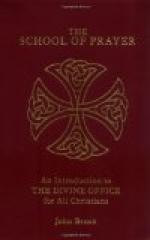In making commemorations, the order of the commemoration as laid down in the Ordo should be followed. Elements of a commemoration are the Antiphon of the Benedictus or the Magnificat with versicle and response. These antiphons are considered most excellent, preceding as they do the Gospel canticles (St. Luke I.). The antiphon, versicle and prayer of the commemoration at an hour should never be repetitions of others said in the same hour. Thus, if in the office of a confessor pontiff having the prayer Da quaesumus, another confessor pontiff’s feast, commemorated in the same hour, should not have the same prayer. About the prayer, or, as it is called, the collect, the following should be noted: first, the commemoration is omitted if the prayer of the office which is being recited and the prayer of the feast to be commemorated have the same object. Thus, a feast of the Blessed Virgin, falling within the octave of the Assumption, should not be commemorated. Second, where a commemoration for a saint or saints of title similar to that of the saints whose office is being said, is to be made, the Congregation of Rites (5th May, 1736) arranged that not even the versicles and response be repeated and that the following order be observed:—
IN VESPERS—
1st Com. made by Antiphon and Versicle of Lauds. 2nd Com. made by Antiphon of second Vesper and Ver. of II. Nocturn. 3rd Com. made by Antiphon of I. Noct. and Vers. of III. Nocturn.
IN LAUDS—
1st Com. made by Antiphon and Vers. from first Vesp. 2nd Com. made by Antiphon I. Noct., and Ver., III. Noct. 3rd Com. made by Antiphon II. Vesp., Vers., II. Noct.
If it should happen in commemorating a day within an octave that the versicle from the common had already been taken for the office, then the rule is “Sumenda est in laudibus antiphona de secundis Vesperis; et pro secundis Vesperis antiphona de laudibus in utroque tamen casu cum v. de primis Vesperis” (S.C.R., 18th Dec., 1779). In the above given form of making commemorations it may be noted that the second commemoration in Lauds is made up from the versicles and response of Matins and not from second Vespers, so as to avoid repeating in Lauds what was said at Vespers (Cavalieri).
As regards prayers in the office the reminder that the same formula must not be repeated in the same hour may be supplemented. Because, prayers having all words identical, save one single word, are not considered in liturgy as different prayers (e.g., Accendamur exemplis; instruamur exemplis, Feast of St. Philip and St. James, Feasts of several martyrs). So, too, prayers which have the same form of petition (e.g., the prayers on feast of St. Joseph and on feast of St. Mathew), are not considered as different and must not be repeated in the same hour. But where the petition is different, even though all the remainder of the prayers are similar in wording, they may be repeated in the same hour.




